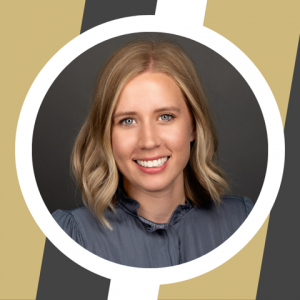
Restoring Function and Confidence for Longtime CU Dental Patient with Innovative Implant Dentistry
For more than 25 years, Rich Hamilton has been a familiar face at the University of Colorado School of Dental Medicine (CU SDM) clinics. At nearly 90 years old, he has undergone extensive dental treatment at the school. His case showcases the power of innovation, collaboration and person-centered care. Under the guidance of Associate Professor David Gozalo, DDS, MS, fourth-year dental student Malik Jackson played a pivotal role in restoring Hamilton’s ability to eat, speak and smile with confidence.
A History of Dental Innovation
Hamilton's journey with dental implants began years ago, with one of his earliest implants placed by Professor Emeritus Lonnie Johnson, DDS, PhD. Over time, he progressively lost more teeth, and while individual implants and implant-supported bridges replaced them, some gaps remained. As a result, he struggled with essential functions like chewing and speaking. By 2024, his remaining natural teeth had deteriorated due to decay and fractures, requiring extractions and a new treatment approach.
Rather than subjecting Hamilton to additional implant surgeries — given his age and medical considerations — Gozalo and Jackson explored a solution that leveraged his existing implants. Their goal was to provide a long-lasting, functional prosthesis while minimizing surgical intervention.
Overcoming Clinical and Practical Challenges
Planning Hamilton’s restoration involved numerous challenges. One of the most significant was his loss of occlusal vertical dimension — the space between his upper and lower teeth necessary for proper prosthesis placement. Additionally, Hamilton had a strong bite and a history of parafunctional habits like nighttime clenching and grinding, increasing the risk of prosthesis failure.
“In a typical case like this, we would design the prosthesis first and then place implants accordingly,” said Jackson. “With Mr. Hamilton, we had to work backwards, using his existing implants and bone levels to dictate what we could do. It was a complex puzzle, but one that we were determined to solve.”
Despite these obstacles, Hamilton remained enthusiastic and optimistic. “I have complete trust in the students and faculty here,” he said. “They’ve taken such great care of me over the years, and I always know I’m in good hands.”
Leveraging Digital Technology for Precision
To create a customized solution, Gozalo and Jackson employed state-of-the-art digital dentistry techniques. They scanned each implant, capturing their exact positions in Hamilton’s mouth. These digital impressions allowed the dental lab to design an optimal prosthesis using computer-aided design and manufacturing (CAD/CAM) technology.
Gozalo said, “One of the challenges in this case was sourcing components for some of the implants Hamilton had received years ago. Finding compatible parts took extensive research and coordination with manufacturers, adding complexity to the treatment process.”
With the help of Beth Keely, CDT, CAD/CAM manager at Gnathodontics dental laboratory, the team created a prototype that allowed for adjustments and refinements before fabricating the final prosthesis.
“We executed this case using a fully digital workflow,” Jackson explained. “Scanning each implant gave us a precise representation of Mr. Hamilton’s mouth, making it possible to design a prosthesis that would fit seamlessly. The accuracy of CAD/CAM technology made all the difference.”
The Final Restoration: Strength and Aesthetics Combined
Gozalo and Jackson ultimately planned a fixed full-arch implant prosthesis. The restoration utilized a titanium Atlantis® BridgeBase with a stained zirconia shell, offering both durability and natural aesthetics. The titanium base provides strength, ensuring the prosthesis can withstand the forces of Hamilton’s strong bite, while the zirconia overlay delivers a lifelike appearance that blends seamlessly with his natural mouth structure.
“A key advantage of using the Atlantis® BridgeBase in this case was its ability to accommodate limited vertical space,” said Gozalo. “Because the existing implants were originally placed to restore single teeth, they were positioned higher than ideal for a full-arch restoration.” The Atlantis® bar system allowed the team to work within these spatial constraints by providing a rigid, low-profile framework that supported the prosthesis without excessive bulk. This solution ensured a functional and aesthetic outcome while maintaining proper prosthetic dimensions.
By utilizing his five remaining implants — despite them being from different brands — the team maximized existing resources without requiring new implant placements. This approach not only spared Hamilton from additional surgical procedures but also expedited his treatment timeline and improved his overall experience.
“This was one of the most rewarding cases I’ve worked on,” said Jackson. “Seeing Mr. Hamilton’s reaction when we delivered the final prosthesis was incredible. He was so happy to have his smile and function back.”
A Transformative Learning Experience
For Jackson, working on Hamilton’s case was a defining moment in his dental education. “This case challenged me to think critically and creatively,” he reflected. “Rather than following a standard treatment plan, we had to adapt to the unique constraints presented by his existing implants and anatomy. The experience reinforced the importance of digital dentistry and how technology can help us provide patient-centered solutions.”
Gozalo’s mentorship played a crucial role in guiding Jackson through the complexities of the case, from planning to execution. “This was more than just placing a prosthesis — it was about problem-solving, thinking outside the box and ensuring that our patient could regain his quality of life,” Jackson said.
A Renewed Smile and Improved Quality of Life
Hamilton’s case exemplifies the transformative power of modern dentistry. His journey highlights the impact of digital workflows, the evolution of implant dentistry and the invaluable hands-on learning experiences that CU SDM provides its students.
For Hamilton, the result is more than just a new set of teeth — it is a renewed ability to enjoy life’s simple pleasures, like eating and speaking comfortably. And for Jackson, it is an unforgettable milestone in his journey to becoming a skilled and compassionate dentist.
Author: Laura Ramsey
Source: https://news.cuanschutz.edu/
 Related articles
Related articles
Products 25 June 2025
ClearChoice Dental Implant Center is proud to introduce Endura Elite, our most advanced full-arch dental restoration yet.
Restorative dentistry 10 February 2025
Dental students' experience and perceived confidence level in different restorative procedures
Graduating confident students who are able to flourish and develop in their future careers is an importance outcome of the dental education.
Jordan Burt has always been passionate about people, and that passion is at the heart of her work as the Human Resources talent acquisition specialist at the University of Colorado School of Dental...
 Read more
Read more
Priyanka Prajapati, a student in the UW School of Dentistry’s International Dentist DDS (UWIDDS) program, has done a tremendous job using interprofessional collaboration to help improve access to...
Oral pathology 06 October 2025
Assessing the Translation of Research and Innovation into Dental Practice
Over the past 100 y, there have been an unprecedented number of innovations that have improved oral health and functioning.
Kuraray Noritake Dental Inc., a global leader in dental material innovation, today launched KATANA Zirconia ONE For IMPLANT at Dentsply Sirona World (DS World).
News 06 October 2025
In response to the growing national shortage of oral health professionals, Planet Smilez is building a pathway for future providers.
News 06 October 2025
Standard Dental Labs Inc., a strategic consolidator of dental laboratories, today announced it has signed five non-binding letters of intent (LOIs) to acquire privately owned, Florida-based dental...














